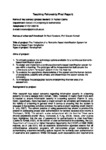The Evaluation of a Biometric-Based Identification System for Remote-Based Exam Invigilation
| dc.contributor.author | Clarke, Nathan | |
| dc.contributor.author | Dowland, P | |
| dc.contributor.author | Furnell, S | |
| dc.contributor.other | Faculty of Science & Engineering | en_US |
| dc.date.accessioned | 2018-08-17T13:10:12Z | |
| dc.date.available | 2018-08-17T13:10:12Z | |
| dc.date.issued | 2013 | |
| dc.identifier.uri | http://hdl.handle.net/10026.1/12171 | |
| dc.description | File replaced (incorrect version) on 01/08/2022 by KT (LDS). | |
| dc.description.abstract |
To critically evaluate the technology options available for a continuous biometric-based identification system. To design and implement a continuous biometric-based identification system for use within e-learning. The prototype will be independent but built around the University’s current Perception system in the first instance. To evaluate the operational characteristics of the system and the human-factors of acceptance, usability and privacy, and disseminate the system across the University. To investigate the pedagogical factors underpinning this new area of e-assessment. Prior research has raised concerns regarding information security in e-learning systems for over a decade now (Littman, 1998). However, in reality much more work is needed to ensure information security in e-learning systems (Ramim & Levy, 2006). Specifically, there has been a major concern by university administrators on the validity of e-learning in general when it comes to ensuring that the student is engaged in the learning activities is indeed the same student receiving credit (Ramim & Levy, 2007). The current practice of using passwords has shown to provide little answer in addressing proper user authentication for several decades now (Morris & Thompson, 1979). This concern is also compounded with the fact that “most users choose passwords poorly” (Katz, Ostrovsky, & Yung, 2009). Indeed, prior studies have highlighted that the use of passwords for authentication is often insufficient (Clarke & Furnell, 2007). In the context of user authentication in e-learning, the U.S. Department of Education’s Higher Education Opportunity Act (HEOP) of 2008 (2008) requires, as of July 2010, that all academic accreditation agencies ensure that all online/distance education programs will demonstrate proper mechanisms for authenticating e-learners including options beyond the currently used authentication of username and password. Whilst US-based, such expectations and requirements in the UK will be forthcoming. Although this mandate is used in terms of its specific requirements, the demand to demonstrate that the student is indeed the same student participating throughout the e-learning activities may pose multiple challenges. To begin with, learners’ activities in e-learning courses vary greatly (Levy, 2008). Developing a single approach to address proper authentication of e-learners throughout all their e-learning activities appears to pose a great challenge. Specifically, to demonstrate continuous authentication whilst undertaking e-learning activities multiple authentication mechanisms will be required for implementation in order to combat intrusive and inconvenient authentication. The University is committed to growing its distance e-learning courses, not only for FT learners but to develop new business opportunities in the CPD market-place. Whilst the focus has been on the technology to produce and deliver e-learning materials, little work has been done on enabling remote exam-based assessments. Such assessments would save students (and tutors) time and money as there would be no need for a physically invigilated session. Remote assessments could widen the range of assessments offered to students, increase uptake of distance-based learning courses and enhance the reputation of PU as a leader in e-assessments. | en_US |
| dc.description.sponsorship | TFAS | en_US |
| dc.language.iso | en | |
| dc.publisher | University of Plymouth | en |
| dc.subject | e-Assessment; e-Invigilation; Biometrics; Invigilation | en_US |
| dc.title | The Evaluation of a Biometric-Based Identification System for Remote-Based Exam Invigilation | en_US |
| dc.type | Report | en_US |
| plymouth.date-start | 2012-2013 | en_US |


